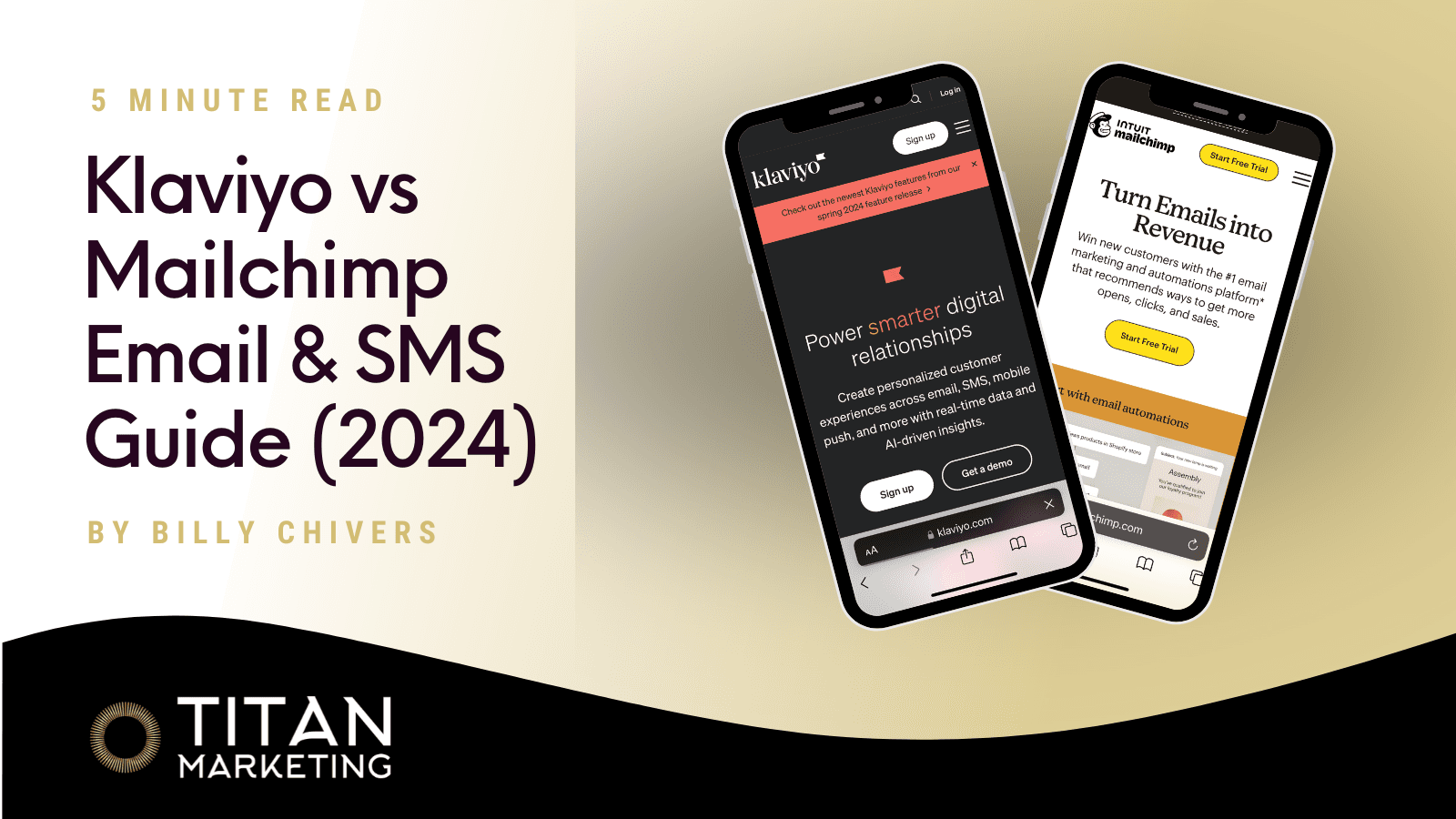
Blog
June 27, 2024

Blog
June 27, 2024

Blog
June 27, 2024
Deciding between Email & SMS platforms? Stuck between Klaviyo & Mailchimp? This guide covers pricing, features, user experience, customer support & user ratings. Everything you need to make a decision for your DTC e-Commerce business.
Introduction
Choosing the right email marketing platform can significantly impact your business's ability to engage with customers and drive sales.
Klaviyo and Mailchimp are two of the most popular email marketing tools available, each offering a range of features designed to help you create effective marketing campaigns.
This guide will compare Klaviyo and Mailchimp across various aspects to help you decide which platform best suits your business needs.
Background & Overview
Mailchimp
Founded in 2001, Mailchimp has evolved into a leading email marketing platform renowned for its user-friendly interface and extensive feature set. It serves businesses of all sizes, offering solutions beyond email marketing, including social media ads, landing pages, postcards, and automation. Mailchimp is known for its ease of use, making it accessible for beginners and small businesses, while still providing powerful tools for larger enterprises.
Klaviyo
Established in 2012, Klaviyo is tailored specifically for eCommerce businesses. It offers advanced email and SMS marketing tools, integrating seamlessly with eCommerce platforms like Shopify, Magento, and WooCommerce. Klaviyo emphasizes data-driven insights and personalized marketing, helping businesses leverage customer data for more targeted campaigns. Klaviyo AI, CDP (Customer Data Platform) & Advanced Analytics are tools to help companies leverage the latest in data analysis to improve their targeting & performance. Discover how Klaviyo’s Predictive Analytics help businesses leverage AI and customer data for targeted marketing strategies.
Pricing Comparison
Pricing is a critical factor when choosing an email marketing platform. Both Klaviyo and Mailchimp offer tiered pricing models based on the number of contacts. This section will compare their pricing plans up to 25,000 contacts, helping you make an informed decision.
Mailchimp Pricing
Mailchimp offers three main pricing tiers: Essentials, Standard, and Premium. Each tier provides different levels of features and support, with costs per plan increasing as the number of contacts grows.
Main Tiers & Contact Levels
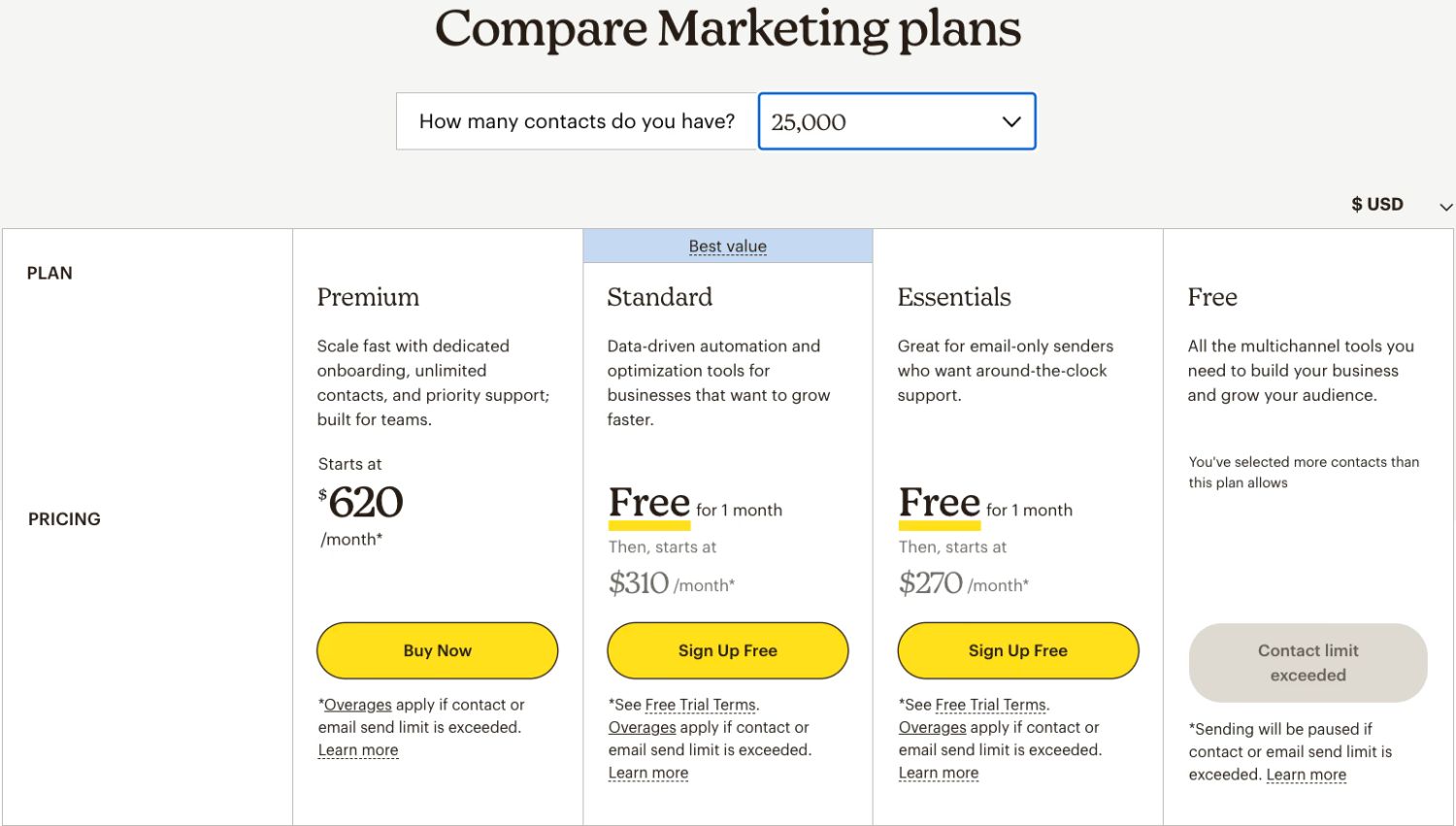
For ease of comparison with Klaviyo, for 25,000 contacts you'd pay:
Essentials: $270/month
Standard: $310/month
Premium: $620/month
Visit this URL to compare plans & input your required contacts to see the pricing estimates.
Key Feature Differences
There are a number of different features, so the main callouts here are as follows:
Number of users:
Free: 1
Essentials: 3
Standard: 5
Premium: Unlimited
If you have a larger team that needs access, opt for a larger tier.
Audiences:
Free: 1
Essentials: 3
Standard: 5
Premium: Unlimited
Segmentation, which is essential, requires 'audiences' to be created. The more you need for your brand, the higher the tier.
Customer Support:
Free: Email support first 30 days
Essentials: 24/7 Email & Chat support
Standard: 24/7 Email & Chat support
Premium: Phone & Priority Support
If you have a custom, complex tech stack & anticipate high levels of support requirements, you might want to opt for the Premium tier.
Journey Points:
Free: none
Essentials: up to 4
Standard: up to 200
Premium: up to 200
Journey points in Mailchimp terminology are rules & actions in a workflow. For example, a Time Delay, 'send email', 'send SMS', and percentage conditional split. You'll only get 4 per flow on 'essentials' so if your flows are complex, you want to include heavy split-testing or segment within flows (e.g. by product interest, purchase history), opt for Standard or above.
The main differences between the plans are as follows (found here):
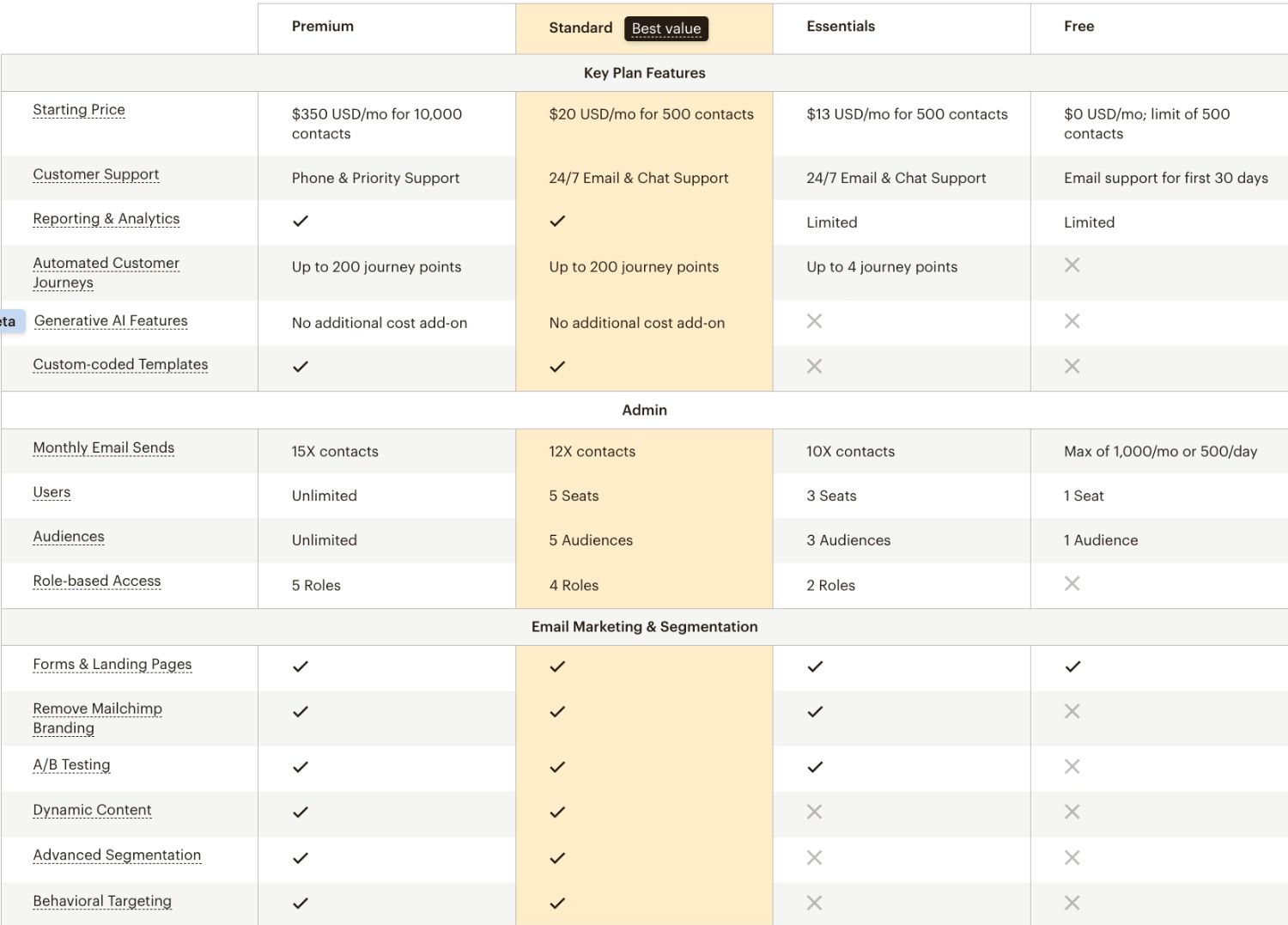
It can be a bit overwhelming, so we'd recommend taking the Mailchimp tier quiz to ensure you receive the right feature set for your specific needs. Just scroll down to 'find my plan' here.
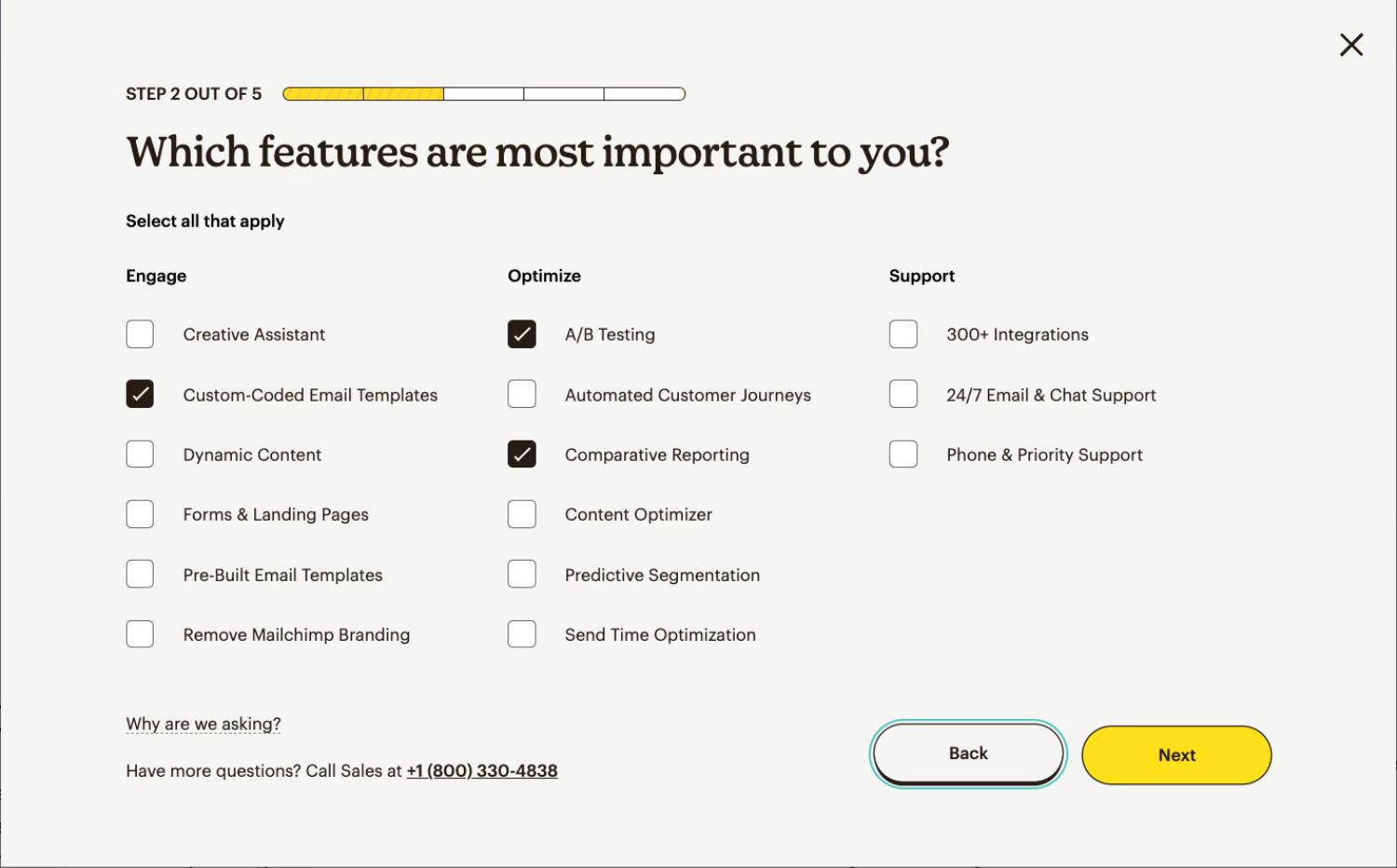
Klaviyo Pricing
Klaviyo’s pricing structure is based on the number of contacts and offers separate pricing for email and email + SMS plans. As your contact list grows, so do the costs, but you gain access to more advanced features and higher message volumes.
Main Tiers & Contact Levels
It's far more simple than Mailchimp. You have Email, Email & SMS and free. And you pay based on active profiles. Head here to see how much you'd pay based on active profiles.

For ease of comparison with Mailchimp, for 25,000 contacts you'd pay:
Email & SMS: $440/month
Email: $425/month
Key Feature Differences
On any paid plan, Klaviyo includes all of the following:

Many brands prefer Klaviyo for it's transparent, simple & flexible approach to pricing.
Conclusion
Out of the two platforms Klaviyo is generally more expensive than Mailchimp's Essentials & Standard plans, but cheaper than its Premium plan.
Given Mailchimp's limitations on the lower plans (in users, journey points & segmentation), established DTC brands may find themselves choosing Mailchimp's Premium Plan anyway to unlock advanced features.
This makes Klaviyo the more cost-effective option, aided by its simple & transparent approach to pricing.
Key Features Comparison
Klaviyo & Mailchimp have varied features across Email & SMS. The below table gives a breakdown (valid as of June 2024) of the key differences.
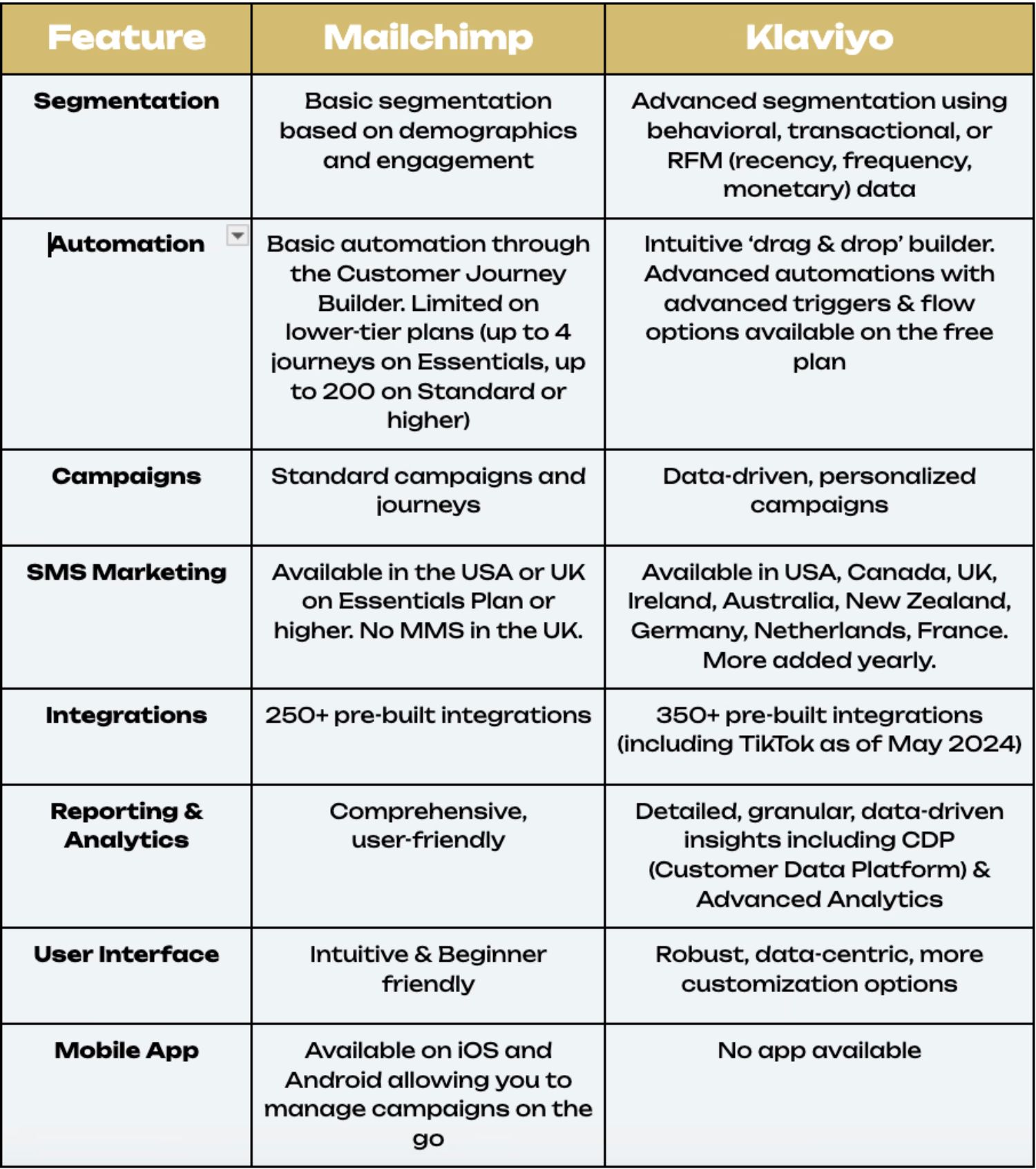
To summarize, while both Mailchimp and Klaviyo offer robust features, they cater to different types of businesses and marketing needs.
Mailchimp is an excellent choice for those looking for a versatile and user-friendly platform with basic segmentation and automation capabilities, making it suitable for small businesses and beginners.
On the other hand, Klaviyo excels in providing advanced segmentation, detailed analytics, and superior automation flows, particularly benefiting eCommerce businesses looking to leverage data-driven marketing strategies. To master SMS abandoned cart flows and boost conversion rates, check out Klaviyo’s SMS Abandoned Cart Ultimate Guide (2024).
Advanced Feature Comparison
The prior section gave a breakdown of the key ‘top level’ features of each platform to help you make an informed decision.
If you’re interested in learning more about the ‘advanced’ technical features that vary between the platforms, here are some key things to consider:
1. Unique Marketing Features
Mailchimp includes features like social post scheduling. These are valuable for businesses looking to extend their marketing efforts beyond email.

Mailchimp's social post scheduling is effective for managing posts across platforms
Klaviyo, on the other hand, is more geared around Email, SMS & Whatsapp (coming soon). Its wider feature set includes Klaviyo Reviews, CDP (unifying your data in one source) & Advanced Analytics (giving you insights across each stage of the conversion funnel).
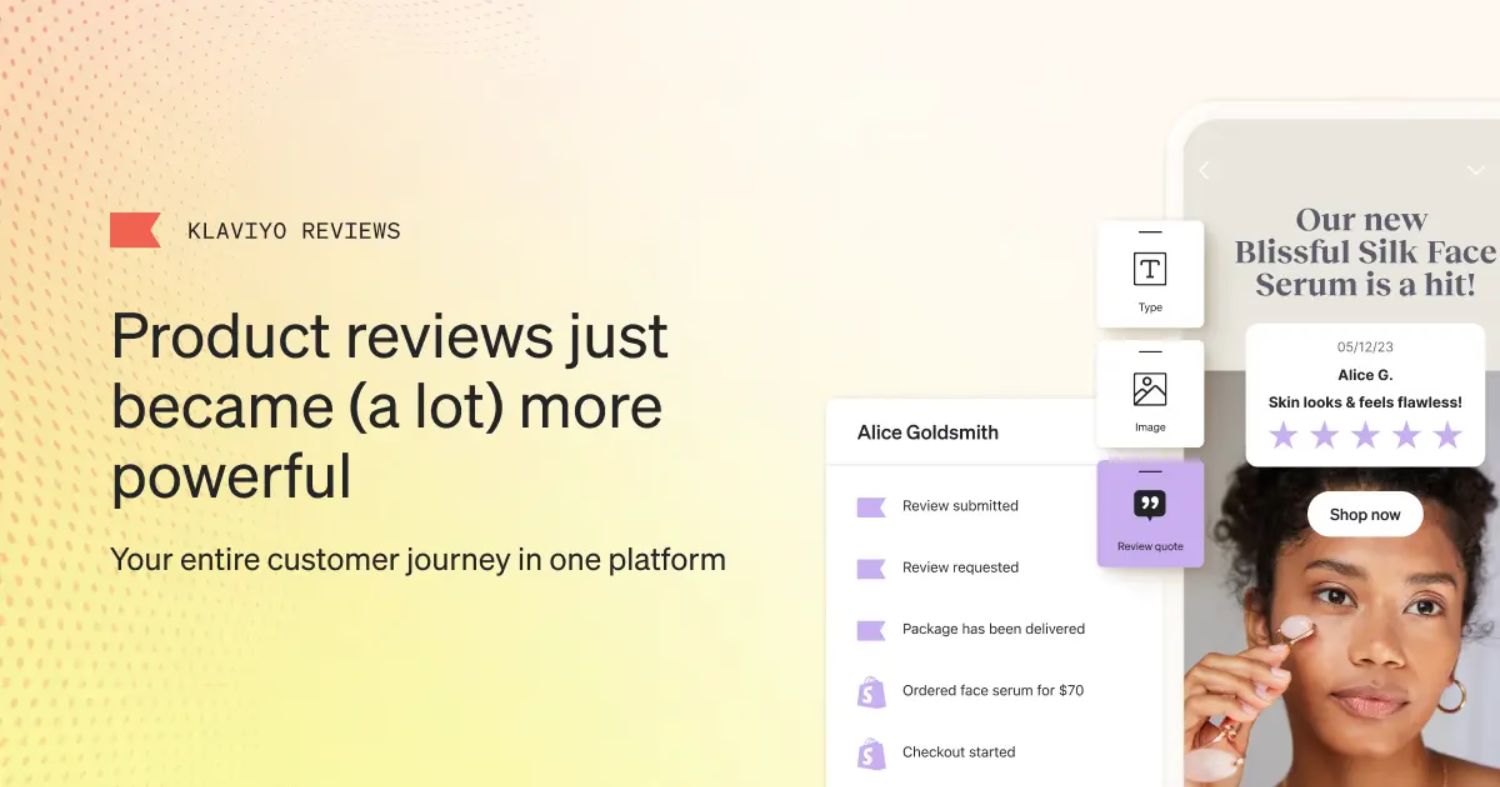
Klaviyo reviews is a powerful way to integrate social proof into the platform.
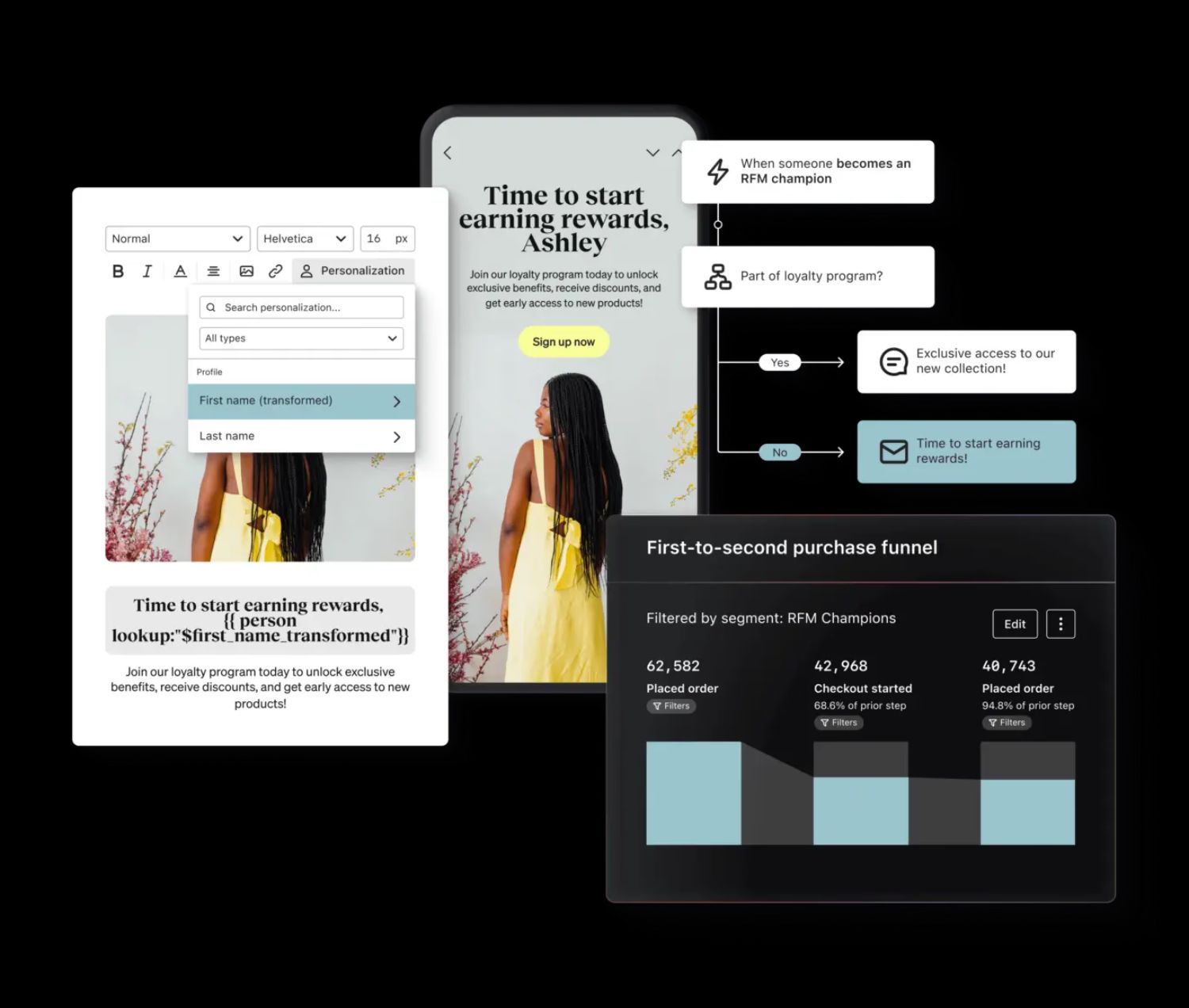
Klaviyo's CDP (Customer Data Platform) helps you make smarter decisions through data.
2. Browse Abandonment Flows
Only 5% of website visitors add to cart. This is a powerful automation with 9.6x higher conversions than the average campaign. They take people who view a product but go no further, sending them an email with the relevant product they were looking at. For inspiration on crafting high-converting browse abandonment emails, review our 12 Browse Abandonment Email Examples.
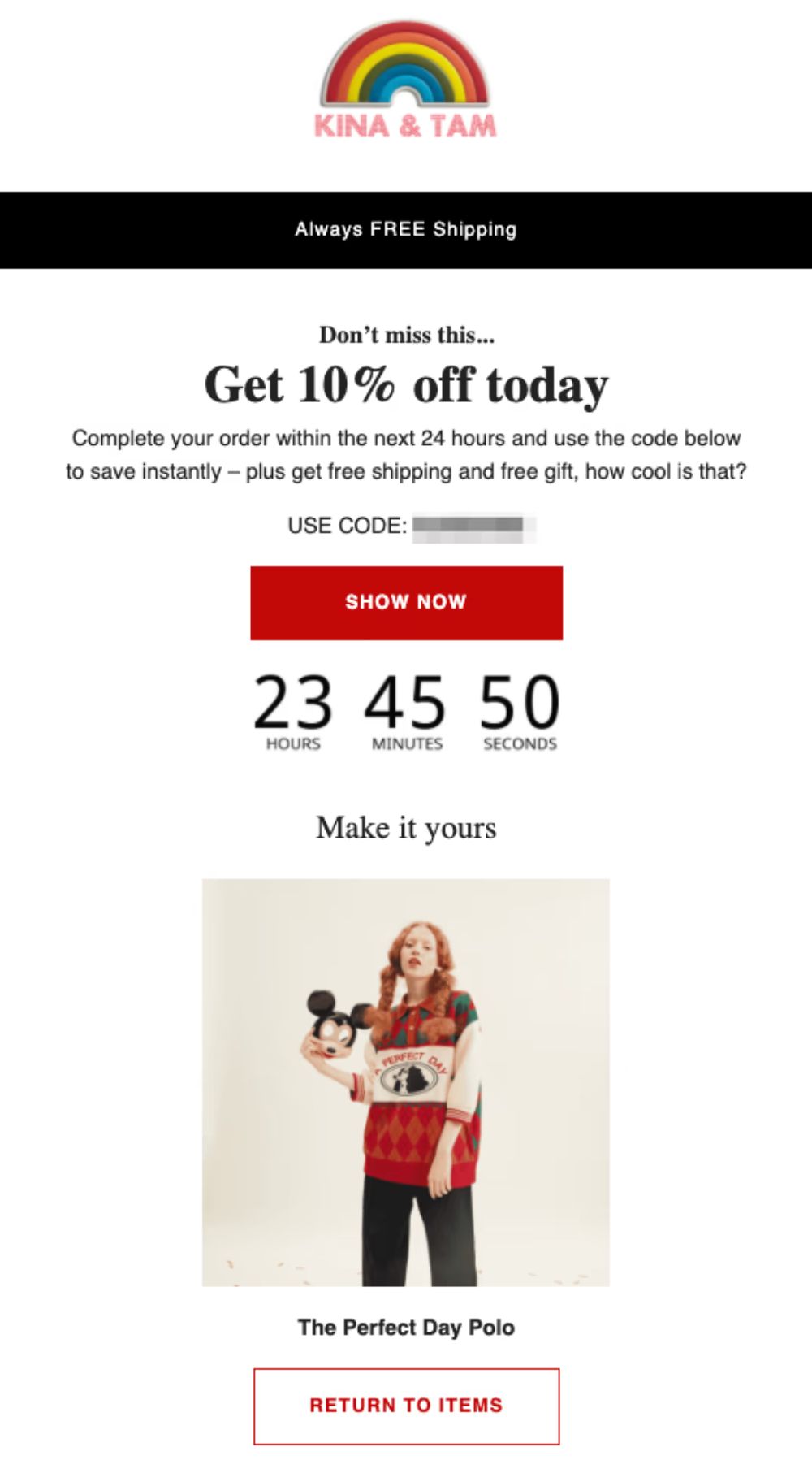
Mailchimp calls these flows ‘Product Retargeting Emails’. They’re similar to Klaviyo’s but less powerful for a number of reasons. Firstly, you choose between ‘newest products’ & ‘bestsellers’, but can only store 8 products for each. If you have a wider number of SKUs, reach is limited. Secondly, subscribers only receive one email in a 7 day period (in Klaviyo you have full control over cadence).
In Klaviyo these are called ‘Browse Abandonment Flows’. They’re very powerful & are available for any product the customer views (there’s no limit). You can send 2-3x emails to customers with a discount for people who’ve never bought, & drive a lot of traffic.
3. Predictive Analytics
AI is key to predict your customers future behaviour & tailor your marketing strategies. Both Klaviyo & Mailchimp have features here, but they differ slightly.
Klaviyo has a team of 140+ AI & Data Scientists. They have a Data Science Podcast too. It’s a huge part of their roadmap. With Klaviyo you can predict the below with concrete stats, and use these to customise your flows & campaigns:
Total Customer Lifetime Value
Predicted Date of Next Order
Average time between orders
Churn risk prediction
Average Order Value
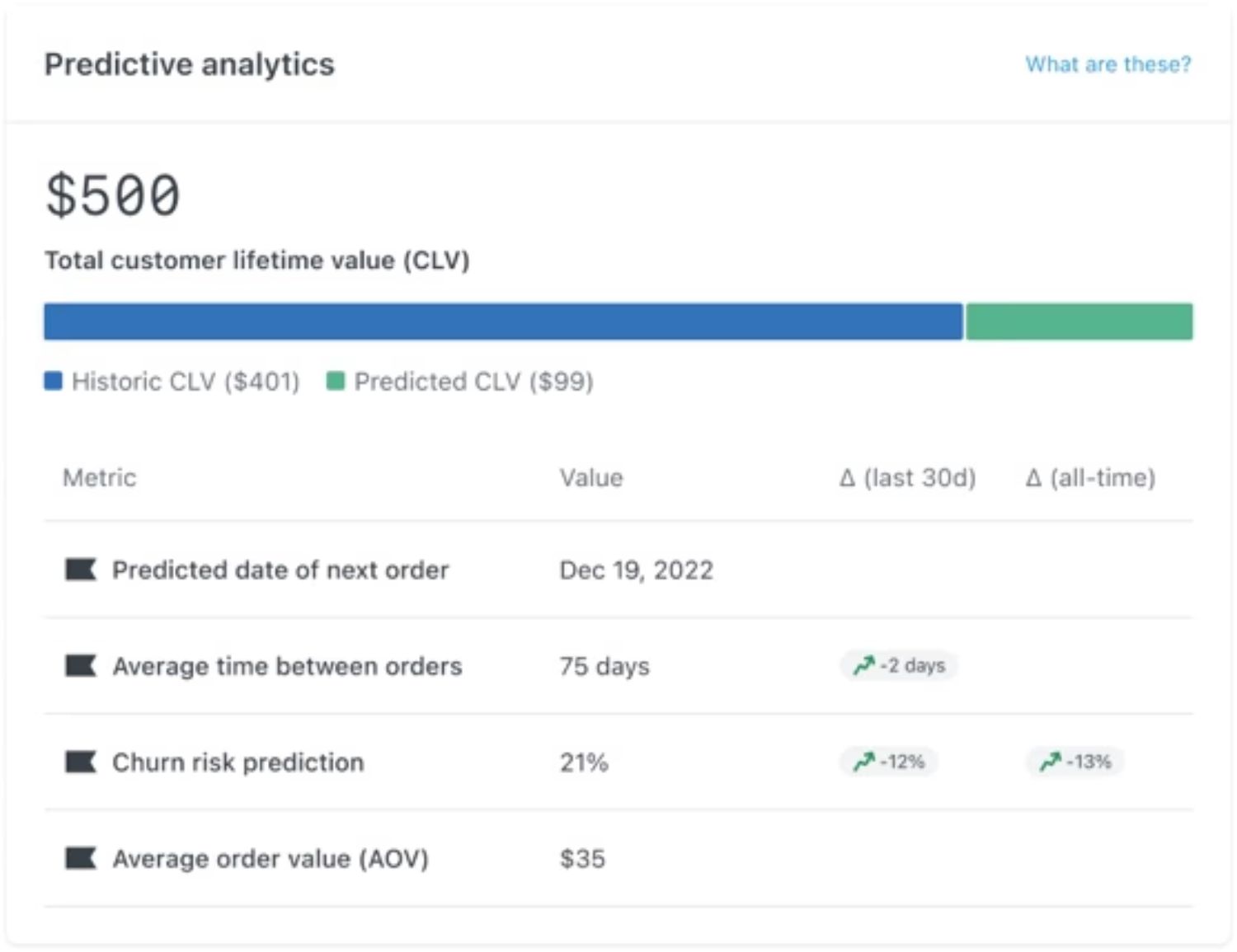
Klaviyo's predictive analytics is comprehensive. Dive deeper into the benefits of predictive analytics in Klaviyo in our AI Guide & 3 Use Cases.
Mailchimp has some degree of predictive analytics, but there’s no concrete numbers. It gives you a score of ‘low’ to ‘high’. You can track:
CLV
Likelihood to purchase

Mailchimp's predictive analytics is more streamlined, with no numeric value.
User Experience
When choosing an email marketing platform, the user interface and ease of use are crucial factors to consider, especially if you are new to email marketing or if your team includes members with varying levels of technical expertise.
Mailchimp UX
Beginner-Friendly Design: Mailchimp is designed with beginners in mind. It offers a straightforward, intuitive interface that makes navigating the platform and creating campaigns simple, even for those with little to no experience in email marketing. The drag-and-drop editor is easy to use, allowing users to quickly design emails and landing pages.
Mailchimp Academy & Guides: Mailchimp provides extensive guided tutorials and helpful resources. Their Mailchimp Academy allows you to get certified in any area of Email & SMS marketing. These tutorials walk users through every step of the process, from setting up their account to creating and sending their first email campaign.
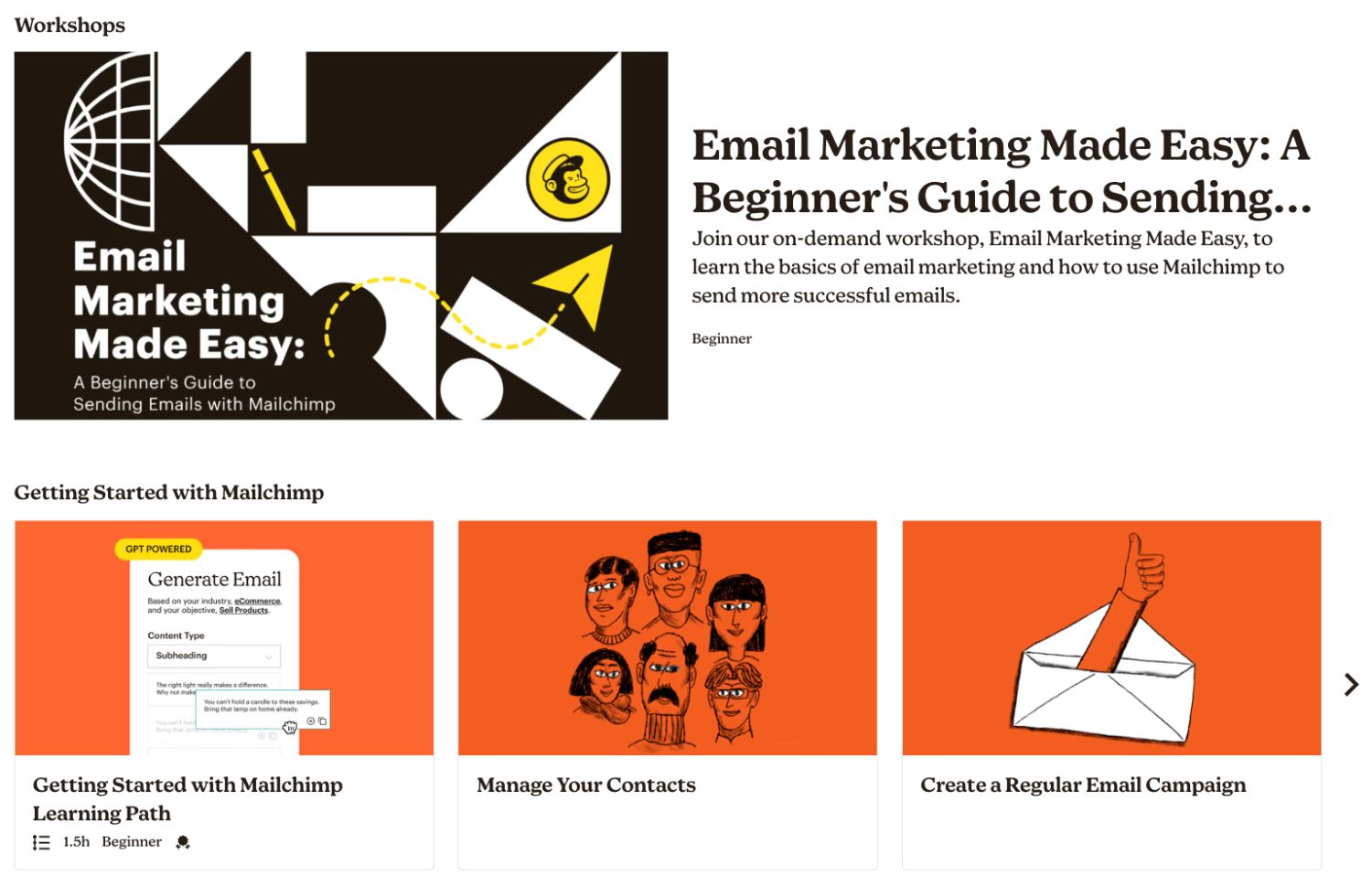
Mailchimp's academy is comprehensive, allowing you to take courses to improve your retention abilities.
Klaviyo UX
Steeper Learning Curve: Klaviyo offers powerful features tailored to more advanced users and eCommerce businesses. As a result, it has a slightly steeper learning curve compared to Mailchimp. However, for users familiar with email marketing and data-driven strategies, Klaviyo's capabilities are well worth the initial investment of time and effort.
Klaviyo Academy & Blog: Klaviyo’s resources are incredible. They invest heavily in upskilling their users, like Mailchimp. Get certified in Klaviyo Academy or follow a process or guide in their blog. Klaviyo forums are also highly active.
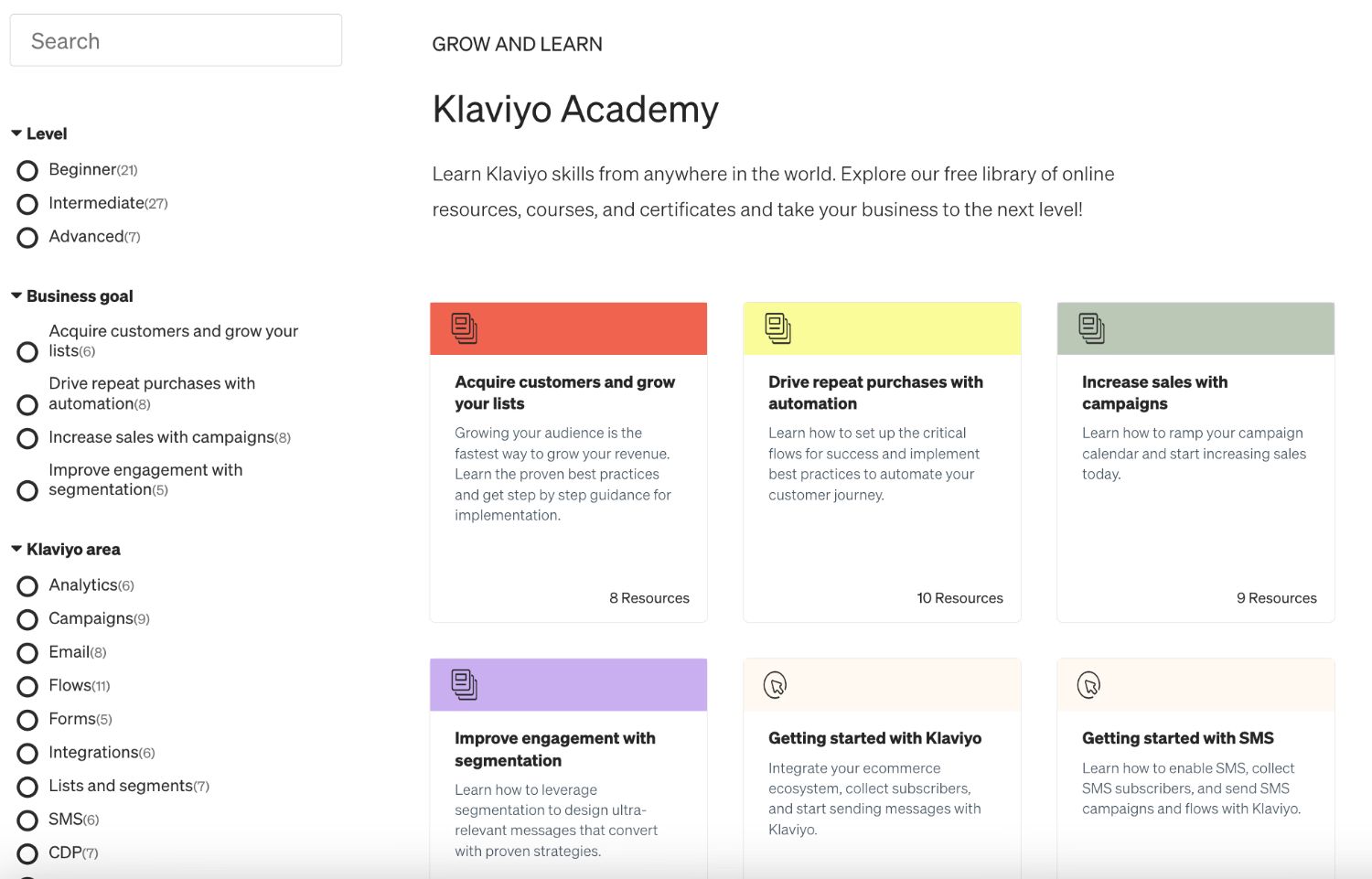
Klaviyo's extensive training helps you offset the steeper learning curve.
Summary:
Klaviyo has a steeper learning curve than Mailchimp given its advanced feature set for e-commerce brands. However, the standard of training & support on both platforms are top notch. Make the decision based on your business needs & be sure you’ll be able to master each platform accordingly.
Customer Support
Customer support is a driving factor of platform choice. The below table summarises the differences between Klaviyo & Mailchimp.
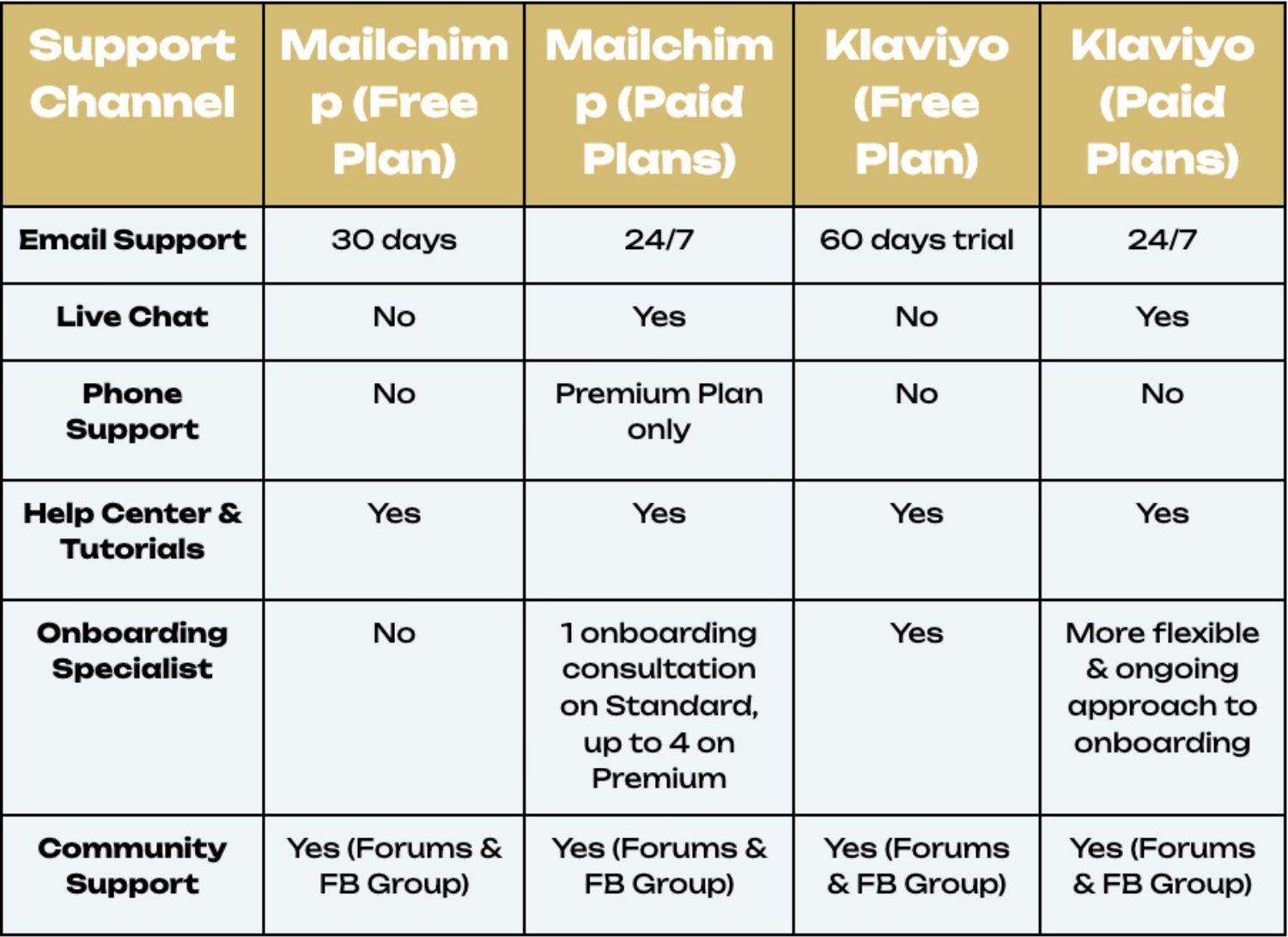
While both Mailchimp and Klaviyo offer comprehensive support options, Klaviyo provides more extensive onboarding support and flexible, ongoing assistance, making it a better choice for businesses needing detailed guidance and advanced features. The 60 days of free email support on the free plan is also advantageous, giving you time to experience the platform and its support without immediate cost.
For a detailed guide on choosing the right email marketing agency to streamline support, read: Hiring An Email Marketing Agency: 8 Steps to Picking the Right One.
User Ratings & Reviews
It’s important to break down user reviews before making your final decision. G2, the world’s leading tech reviewer, has a good breakdown of Mailchimp vs Klaviyo. Valid as of 27.6.24.
Overview:
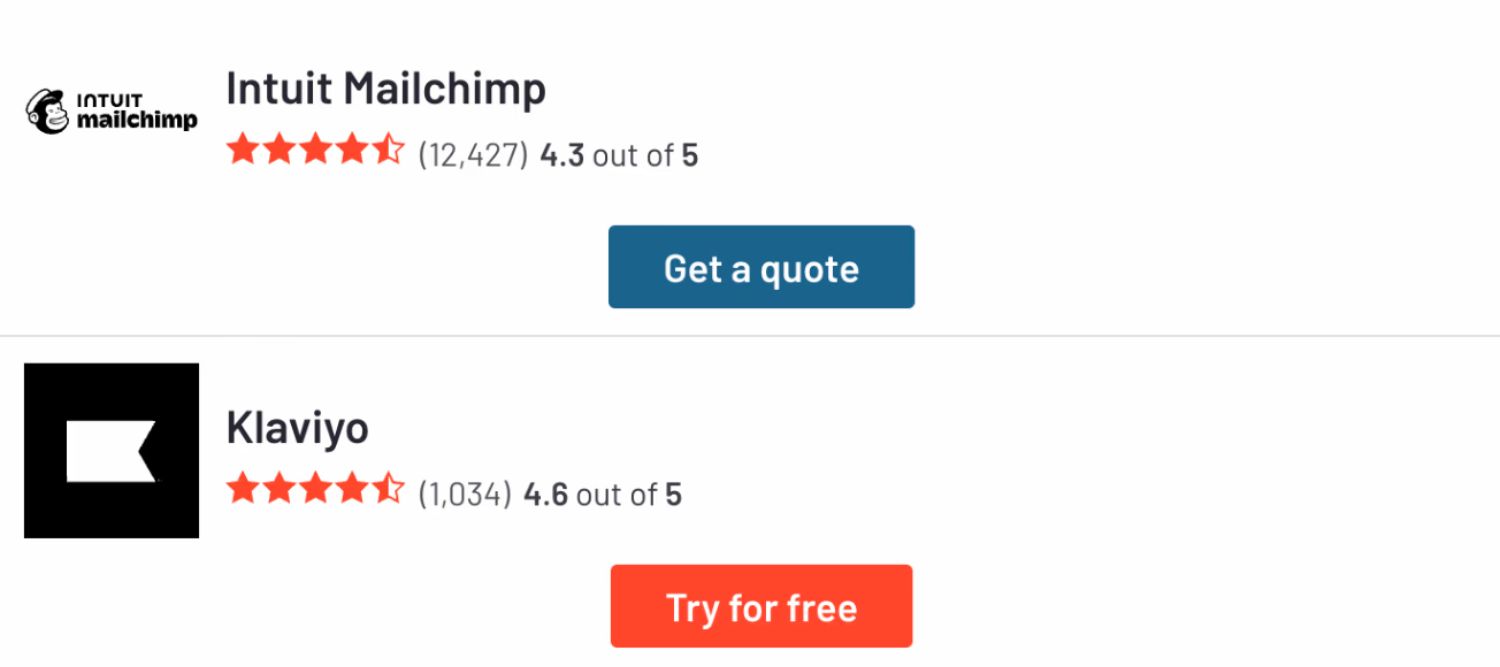
Whilst Mailchimp has more reviews, Klaviyo has a 4.6/5 vs its 4.3/5.
Meets Requirements:

Reviews are more likely to say Klaviyo ‘meets’ their requirements than Mailchimp. Likely due to the more customisable nature of the platform.
Ease of Use:

Whilst Klaviyo objectively is more complex, they are reviewed as being the same ‘ease of use’. This is likely due to Klaviyo’s extensive training matching Mailchimp’s.
Ease of Setup:

Mailchimp has a slightly higher ease of setup than Klaviyo.
Quality of Support:

Klaviyo has a higher quality of support rating than Mailchimp. This is validated by our assessment above.
Product Direction:

This is a central metric. It’s important to do business with companies that are innovative & adapting to the wider marketing landscape. Klaviyo’s AI & wider feature set (Reviews, CDP & Advanced Analytics) are top tier, and there’s much more to come. Explore how Klaviyo’s Smart Sending feature optimizes email frequency and improves engagement.
Choosing Klaviyo vs Mailchimp…
Choosing between Klaviyo and Mailchimp depends on your business needs and marketing goals.
Mailchimp offers a user-friendly, affordable solution ideal for small businesses and beginners. Its straightforward interface, guided tutorials, and extensive features like social media management make it versatile and accessible. Mailchimp's pricing is generally lower (on plans except Premium), making it an attractive option for those with simpler marketing needs.
Klaviyo, on the other hand, provides advanced features, robust eCommerce integrations, and powerful data-driven marketing tools. It's designed for businesses looking to leverage detailed customer data for personalized and effective marketing campaigns. While it comes at a higher cost (than Mailchimp’s lowest two paid plans) and has a steeper learning curve, the investment is justified by its advanced segmentation, comprehensive analytics, and superior automation capabilities. Klaviyo's extensive onboarding support and flexible, ongoing assistance make it a strong choice for eCommerce businesses aiming to optimize their marketing strategies.
Conclusion
Both platforms are strong choices for retention marketing. Mailchimp is the ‘traditional’ platform (with over 11 million users) founded in 2001, whilst Klaviyo is the challenger founded in 2012 specifically for the e-commerce space.
For small businesses or those new to email marketing, Mailchimp is a solid option due to its ease of use and lower cost. For eCommerce businesses looking for advanced features and detailed customer insights, Klaviyo is the superior choice, offering the tools necessary to drive targeted and effective marketing campaigns.
Grab Your Free Advice…
Still can't decide which platform is right for you? Schedule a free audit - we'll help assess your needs & make the right decision!
Introduction
Choosing the right email marketing platform can significantly impact your business's ability to engage with customers and drive sales.
Klaviyo and Mailchimp are two of the most popular email marketing tools available, each offering a range of features designed to help you create effective marketing campaigns.
This guide will compare Klaviyo and Mailchimp across various aspects to help you decide which platform best suits your business needs.
Background & Overview
Mailchimp
Founded in 2001, Mailchimp has evolved into a leading email marketing platform renowned for its user-friendly interface and extensive feature set. It serves businesses of all sizes, offering solutions beyond email marketing, including social media ads, landing pages, postcards, and automation. Mailchimp is known for its ease of use, making it accessible for beginners and small businesses, while still providing powerful tools for larger enterprises.
Klaviyo
Established in 2012, Klaviyo is tailored specifically for eCommerce businesses. It offers advanced email and SMS marketing tools, integrating seamlessly with eCommerce platforms like Shopify, Magento, and WooCommerce. Klaviyo emphasizes data-driven insights and personalized marketing, helping businesses leverage customer data for more targeted campaigns. Klaviyo AI, CDP (Customer Data Platform) & Advanced Analytics are tools to help companies leverage the latest in data analysis to improve their targeting & performance. Discover how Klaviyo’s Predictive Analytics help businesses leverage AI and customer data for targeted marketing strategies.
Pricing Comparison
Pricing is a critical factor when choosing an email marketing platform. Both Klaviyo and Mailchimp offer tiered pricing models based on the number of contacts. This section will compare their pricing plans up to 25,000 contacts, helping you make an informed decision.
Mailchimp Pricing
Mailchimp offers three main pricing tiers: Essentials, Standard, and Premium. Each tier provides different levels of features and support, with costs per plan increasing as the number of contacts grows.
Main Tiers & Contact Levels

For ease of comparison with Klaviyo, for 25,000 contacts you'd pay:
Essentials: $270/month
Standard: $310/month
Premium: $620/month
Visit this URL to compare plans & input your required contacts to see the pricing estimates.
Key Feature Differences
There are a number of different features, so the main callouts here are as follows:
Number of users:
Free: 1
Essentials: 3
Standard: 5
Premium: Unlimited
If you have a larger team that needs access, opt for a larger tier.
Audiences:
Free: 1
Essentials: 3
Standard: 5
Premium: Unlimited
Segmentation, which is essential, requires 'audiences' to be created. The more you need for your brand, the higher the tier.
Customer Support:
Free: Email support first 30 days
Essentials: 24/7 Email & Chat support
Standard: 24/7 Email & Chat support
Premium: Phone & Priority Support
If you have a custom, complex tech stack & anticipate high levels of support requirements, you might want to opt for the Premium tier.
Journey Points:
Free: none
Essentials: up to 4
Standard: up to 200
Premium: up to 200
Journey points in Mailchimp terminology are rules & actions in a workflow. For example, a Time Delay, 'send email', 'send SMS', and percentage conditional split. You'll only get 4 per flow on 'essentials' so if your flows are complex, you want to include heavy split-testing or segment within flows (e.g. by product interest, purchase history), opt for Standard or above.
The main differences between the plans are as follows (found here):

It can be a bit overwhelming, so we'd recommend taking the Mailchimp tier quiz to ensure you receive the right feature set for your specific needs. Just scroll down to 'find my plan' here.

Klaviyo Pricing
Klaviyo’s pricing structure is based on the number of contacts and offers separate pricing for email and email + SMS plans. As your contact list grows, so do the costs, but you gain access to more advanced features and higher message volumes.
Main Tiers & Contact Levels
It's far more simple than Mailchimp. You have Email, Email & SMS and free. And you pay based on active profiles. Head here to see how much you'd pay based on active profiles.

For ease of comparison with Mailchimp, for 25,000 contacts you'd pay:
Email & SMS: $440/month
Email: $425/month
Key Feature Differences
On any paid plan, Klaviyo includes all of the following:

Many brands prefer Klaviyo for it's transparent, simple & flexible approach to pricing.
Conclusion
Out of the two platforms Klaviyo is generally more expensive than Mailchimp's Essentials & Standard plans, but cheaper than its Premium plan.
Given Mailchimp's limitations on the lower plans (in users, journey points & segmentation), established DTC brands may find themselves choosing Mailchimp's Premium Plan anyway to unlock advanced features.
This makes Klaviyo the more cost-effective option, aided by its simple & transparent approach to pricing.
Key Features Comparison
Klaviyo & Mailchimp have varied features across Email & SMS. The below table gives a breakdown (valid as of June 2024) of the key differences.

To summarize, while both Mailchimp and Klaviyo offer robust features, they cater to different types of businesses and marketing needs.
Mailchimp is an excellent choice for those looking for a versatile and user-friendly platform with basic segmentation and automation capabilities, making it suitable for small businesses and beginners.
On the other hand, Klaviyo excels in providing advanced segmentation, detailed analytics, and superior automation flows, particularly benefiting eCommerce businesses looking to leverage data-driven marketing strategies. To master SMS abandoned cart flows and boost conversion rates, check out Klaviyo’s SMS Abandoned Cart Ultimate Guide (2024).
Advanced Feature Comparison
The prior section gave a breakdown of the key ‘top level’ features of each platform to help you make an informed decision.
If you’re interested in learning more about the ‘advanced’ technical features that vary between the platforms, here are some key things to consider:
1. Unique Marketing Features
Mailchimp includes features like social post scheduling. These are valuable for businesses looking to extend their marketing efforts beyond email.

Mailchimp's social post scheduling is effective for managing posts across platforms
Klaviyo, on the other hand, is more geared around Email, SMS & Whatsapp (coming soon). Its wider feature set includes Klaviyo Reviews, CDP (unifying your data in one source) & Advanced Analytics (giving you insights across each stage of the conversion funnel).

Klaviyo reviews is a powerful way to integrate social proof into the platform.

Klaviyo's CDP (Customer Data Platform) helps you make smarter decisions through data.
2. Browse Abandonment Flows
Only 5% of website visitors add to cart. This is a powerful automation with 9.6x higher conversions than the average campaign. They take people who view a product but go no further, sending them an email with the relevant product they were looking at. For inspiration on crafting high-converting browse abandonment emails, review our 12 Browse Abandonment Email Examples.

Mailchimp calls these flows ‘Product Retargeting Emails’. They’re similar to Klaviyo’s but less powerful for a number of reasons. Firstly, you choose between ‘newest products’ & ‘bestsellers’, but can only store 8 products for each. If you have a wider number of SKUs, reach is limited. Secondly, subscribers only receive one email in a 7 day period (in Klaviyo you have full control over cadence).
In Klaviyo these are called ‘Browse Abandonment Flows’. They’re very powerful & are available for any product the customer views (there’s no limit). You can send 2-3x emails to customers with a discount for people who’ve never bought, & drive a lot of traffic.
3. Predictive Analytics
AI is key to predict your customers future behaviour & tailor your marketing strategies. Both Klaviyo & Mailchimp have features here, but they differ slightly.
Klaviyo has a team of 140+ AI & Data Scientists. They have a Data Science Podcast too. It’s a huge part of their roadmap. With Klaviyo you can predict the below with concrete stats, and use these to customise your flows & campaigns:
Total Customer Lifetime Value
Predicted Date of Next Order
Average time between orders
Churn risk prediction
Average Order Value

Klaviyo's predictive analytics is comprehensive. Dive deeper into the benefits of predictive analytics in Klaviyo in our AI Guide & 3 Use Cases.
Mailchimp has some degree of predictive analytics, but there’s no concrete numbers. It gives you a score of ‘low’ to ‘high’. You can track:
CLV
Likelihood to purchase

Mailchimp's predictive analytics is more streamlined, with no numeric value.
User Experience
When choosing an email marketing platform, the user interface and ease of use are crucial factors to consider, especially if you are new to email marketing or if your team includes members with varying levels of technical expertise.
Mailchimp UX
Beginner-Friendly Design: Mailchimp is designed with beginners in mind. It offers a straightforward, intuitive interface that makes navigating the platform and creating campaigns simple, even for those with little to no experience in email marketing. The drag-and-drop editor is easy to use, allowing users to quickly design emails and landing pages.
Mailchimp Academy & Guides: Mailchimp provides extensive guided tutorials and helpful resources. Their Mailchimp Academy allows you to get certified in any area of Email & SMS marketing. These tutorials walk users through every step of the process, from setting up their account to creating and sending their first email campaign.

Mailchimp's academy is comprehensive, allowing you to take courses to improve your retention abilities.
Klaviyo UX
Steeper Learning Curve: Klaviyo offers powerful features tailored to more advanced users and eCommerce businesses. As a result, it has a slightly steeper learning curve compared to Mailchimp. However, for users familiar with email marketing and data-driven strategies, Klaviyo's capabilities are well worth the initial investment of time and effort.
Klaviyo Academy & Blog: Klaviyo’s resources are incredible. They invest heavily in upskilling their users, like Mailchimp. Get certified in Klaviyo Academy or follow a process or guide in their blog. Klaviyo forums are also highly active.

Klaviyo's extensive training helps you offset the steeper learning curve.
Summary:
Klaviyo has a steeper learning curve than Mailchimp given its advanced feature set for e-commerce brands. However, the standard of training & support on both platforms are top notch. Make the decision based on your business needs & be sure you’ll be able to master each platform accordingly.
Customer Support
Customer support is a driving factor of platform choice. The below table summarises the differences between Klaviyo & Mailchimp.

While both Mailchimp and Klaviyo offer comprehensive support options, Klaviyo provides more extensive onboarding support and flexible, ongoing assistance, making it a better choice for businesses needing detailed guidance and advanced features. The 60 days of free email support on the free plan is also advantageous, giving you time to experience the platform and its support without immediate cost.
For a detailed guide on choosing the right email marketing agency to streamline support, read: Hiring An Email Marketing Agency: 8 Steps to Picking the Right One.
User Ratings & Reviews
It’s important to break down user reviews before making your final decision. G2, the world’s leading tech reviewer, has a good breakdown of Mailchimp vs Klaviyo. Valid as of 27.6.24.
Overview:

Whilst Mailchimp has more reviews, Klaviyo has a 4.6/5 vs its 4.3/5.
Meets Requirements:

Reviews are more likely to say Klaviyo ‘meets’ their requirements than Mailchimp. Likely due to the more customisable nature of the platform.
Ease of Use:

Whilst Klaviyo objectively is more complex, they are reviewed as being the same ‘ease of use’. This is likely due to Klaviyo’s extensive training matching Mailchimp’s.
Ease of Setup:

Mailchimp has a slightly higher ease of setup than Klaviyo.
Quality of Support:

Klaviyo has a higher quality of support rating than Mailchimp. This is validated by our assessment above.
Product Direction:

This is a central metric. It’s important to do business with companies that are innovative & adapting to the wider marketing landscape. Klaviyo’s AI & wider feature set (Reviews, CDP & Advanced Analytics) are top tier, and there’s much more to come. Explore how Klaviyo’s Smart Sending feature optimizes email frequency and improves engagement.
Choosing Klaviyo vs Mailchimp…
Choosing between Klaviyo and Mailchimp depends on your business needs and marketing goals.
Mailchimp offers a user-friendly, affordable solution ideal for small businesses and beginners. Its straightforward interface, guided tutorials, and extensive features like social media management make it versatile and accessible. Mailchimp's pricing is generally lower (on plans except Premium), making it an attractive option for those with simpler marketing needs.
Klaviyo, on the other hand, provides advanced features, robust eCommerce integrations, and powerful data-driven marketing tools. It's designed for businesses looking to leverage detailed customer data for personalized and effective marketing campaigns. While it comes at a higher cost (than Mailchimp’s lowest two paid plans) and has a steeper learning curve, the investment is justified by its advanced segmentation, comprehensive analytics, and superior automation capabilities. Klaviyo's extensive onboarding support and flexible, ongoing assistance make it a strong choice for eCommerce businesses aiming to optimize their marketing strategies.
Conclusion
Both platforms are strong choices for retention marketing. Mailchimp is the ‘traditional’ platform (with over 11 million users) founded in 2001, whilst Klaviyo is the challenger founded in 2012 specifically for the e-commerce space.
For small businesses or those new to email marketing, Mailchimp is a solid option due to its ease of use and lower cost. For eCommerce businesses looking for advanced features and detailed customer insights, Klaviyo is the superior choice, offering the tools necessary to drive targeted and effective marketing campaigns.
Grab Your Free Advice…
Still can't decide which platform is right for you? Schedule a free audit - we'll help assess your needs & make the right decision!
Deciding between Email & SMS platforms? Stuck between Klaviyo & Mailchimp? This guide covers pricing, features, user experience, customer support & user ratings. Everything you need to make a decision for your DTC e-Commerce business.
Introduction
Choosing the right email marketing platform can significantly impact your business's ability to engage with customers and drive sales.
Klaviyo and Mailchimp are two of the most popular email marketing tools available, each offering a range of features designed to help you create effective marketing campaigns.
This guide will compare Klaviyo and Mailchimp across various aspects to help you decide which platform best suits your business needs.
Background & Overview
Mailchimp
Founded in 2001, Mailchimp has evolved into a leading email marketing platform renowned for its user-friendly interface and extensive feature set. It serves businesses of all sizes, offering solutions beyond email marketing, including social media ads, landing pages, postcards, and automation. Mailchimp is known for its ease of use, making it accessible for beginners and small businesses, while still providing powerful tools for larger enterprises.
Klaviyo
Established in 2012, Klaviyo is tailored specifically for eCommerce businesses. It offers advanced email and SMS marketing tools, integrating seamlessly with eCommerce platforms like Shopify, Magento, and WooCommerce. Klaviyo emphasizes data-driven insights and personalized marketing, helping businesses leverage customer data for more targeted campaigns. Klaviyo AI, CDP (Customer Data Platform) & Advanced Analytics are tools to help companies leverage the latest in data analysis to improve their targeting & performance. Discover how Klaviyo’s Predictive Analytics help businesses leverage AI and customer data for targeted marketing strategies.
Pricing Comparison
Pricing is a critical factor when choosing an email marketing platform. Both Klaviyo and Mailchimp offer tiered pricing models based on the number of contacts. This section will compare their pricing plans up to 25,000 contacts, helping you make an informed decision.
Mailchimp Pricing
Mailchimp offers three main pricing tiers: Essentials, Standard, and Premium. Each tier provides different levels of features and support, with costs per plan increasing as the number of contacts grows.
Main Tiers & Contact Levels

For ease of comparison with Klaviyo, for 25,000 contacts you'd pay:
Essentials: $270/month
Standard: $310/month
Premium: $620/month
Visit this URL to compare plans & input your required contacts to see the pricing estimates.
Key Feature Differences
There are a number of different features, so the main callouts here are as follows:
Number of users:
Free: 1
Essentials: 3
Standard: 5
Premium: Unlimited
If you have a larger team that needs access, opt for a larger tier.
Audiences:
Free: 1
Essentials: 3
Standard: 5
Premium: Unlimited
Segmentation, which is essential, requires 'audiences' to be created. The more you need for your brand, the higher the tier.
Customer Support:
Free: Email support first 30 days
Essentials: 24/7 Email & Chat support
Standard: 24/7 Email & Chat support
Premium: Phone & Priority Support
If you have a custom, complex tech stack & anticipate high levels of support requirements, you might want to opt for the Premium tier.
Journey Points:
Free: none
Essentials: up to 4
Standard: up to 200
Premium: up to 200
Journey points in Mailchimp terminology are rules & actions in a workflow. For example, a Time Delay, 'send email', 'send SMS', and percentage conditional split. You'll only get 4 per flow on 'essentials' so if your flows are complex, you want to include heavy split-testing or segment within flows (e.g. by product interest, purchase history), opt for Standard or above.
The main differences between the plans are as follows (found here):

It can be a bit overwhelming, so we'd recommend taking the Mailchimp tier quiz to ensure you receive the right feature set for your specific needs. Just scroll down to 'find my plan' here.

Klaviyo Pricing
Klaviyo’s pricing structure is based on the number of contacts and offers separate pricing for email and email + SMS plans. As your contact list grows, so do the costs, but you gain access to more advanced features and higher message volumes.
Main Tiers & Contact Levels
It's far more simple than Mailchimp. You have Email, Email & SMS and free. And you pay based on active profiles. Head here to see how much you'd pay based on active profiles.

For ease of comparison with Mailchimp, for 25,000 contacts you'd pay:
Email & SMS: $440/month
Email: $425/month
Key Feature Differences
On any paid plan, Klaviyo includes all of the following:

Many brands prefer Klaviyo for it's transparent, simple & flexible approach to pricing.
Conclusion
Out of the two platforms Klaviyo is generally more expensive than Mailchimp's Essentials & Standard plans, but cheaper than its Premium plan.
Given Mailchimp's limitations on the lower plans (in users, journey points & segmentation), established DTC brands may find themselves choosing Mailchimp's Premium Plan anyway to unlock advanced features.
This makes Klaviyo the more cost-effective option, aided by its simple & transparent approach to pricing.
Key Features Comparison
Klaviyo & Mailchimp have varied features across Email & SMS. The below table gives a breakdown (valid as of June 2024) of the key differences.

To summarize, while both Mailchimp and Klaviyo offer robust features, they cater to different types of businesses and marketing needs.
Mailchimp is an excellent choice for those looking for a versatile and user-friendly platform with basic segmentation and automation capabilities, making it suitable for small businesses and beginners.
On the other hand, Klaviyo excels in providing advanced segmentation, detailed analytics, and superior automation flows, particularly benefiting eCommerce businesses looking to leverage data-driven marketing strategies. To master SMS abandoned cart flows and boost conversion rates, check out Klaviyo’s SMS Abandoned Cart Ultimate Guide (2024).
Advanced Feature Comparison
The prior section gave a breakdown of the key ‘top level’ features of each platform to help you make an informed decision.
If you’re interested in learning more about the ‘advanced’ technical features that vary between the platforms, here are some key things to consider:
1. Unique Marketing Features
Mailchimp includes features like social post scheduling. These are valuable for businesses looking to extend their marketing efforts beyond email.

Mailchimp's social post scheduling is effective for managing posts across platforms
Klaviyo, on the other hand, is more geared around Email, SMS & Whatsapp (coming soon). Its wider feature set includes Klaviyo Reviews, CDP (unifying your data in one source) & Advanced Analytics (giving you insights across each stage of the conversion funnel).

Klaviyo reviews is a powerful way to integrate social proof into the platform.

Klaviyo's CDP (Customer Data Platform) helps you make smarter decisions through data.
2. Browse Abandonment Flows
Only 5% of website visitors add to cart. This is a powerful automation with 9.6x higher conversions than the average campaign. They take people who view a product but go no further, sending them an email with the relevant product they were looking at. For inspiration on crafting high-converting browse abandonment emails, review our 12 Browse Abandonment Email Examples.

Mailchimp calls these flows ‘Product Retargeting Emails’. They’re similar to Klaviyo’s but less powerful for a number of reasons. Firstly, you choose between ‘newest products’ & ‘bestsellers’, but can only store 8 products for each. If you have a wider number of SKUs, reach is limited. Secondly, subscribers only receive one email in a 7 day period (in Klaviyo you have full control over cadence).
In Klaviyo these are called ‘Browse Abandonment Flows’. They’re very powerful & are available for any product the customer views (there’s no limit). You can send 2-3x emails to customers with a discount for people who’ve never bought, & drive a lot of traffic.
3. Predictive Analytics
AI is key to predict your customers future behaviour & tailor your marketing strategies. Both Klaviyo & Mailchimp have features here, but they differ slightly.
Klaviyo has a team of 140+ AI & Data Scientists. They have a Data Science Podcast too. It’s a huge part of their roadmap. With Klaviyo you can predict the below with concrete stats, and use these to customise your flows & campaigns:
Total Customer Lifetime Value
Predicted Date of Next Order
Average time between orders
Churn risk prediction
Average Order Value

Klaviyo's predictive analytics is comprehensive. Dive deeper into the benefits of predictive analytics in Klaviyo in our AI Guide & 3 Use Cases.
Mailchimp has some degree of predictive analytics, but there’s no concrete numbers. It gives you a score of ‘low’ to ‘high’. You can track:
CLV
Likelihood to purchase

Mailchimp's predictive analytics is more streamlined, with no numeric value.
User Experience
When choosing an email marketing platform, the user interface and ease of use are crucial factors to consider, especially if you are new to email marketing or if your team includes members with varying levels of technical expertise.
Mailchimp UX
Beginner-Friendly Design: Mailchimp is designed with beginners in mind. It offers a straightforward, intuitive interface that makes navigating the platform and creating campaigns simple, even for those with little to no experience in email marketing. The drag-and-drop editor is easy to use, allowing users to quickly design emails and landing pages.
Mailchimp Academy & Guides: Mailchimp provides extensive guided tutorials and helpful resources. Their Mailchimp Academy allows you to get certified in any area of Email & SMS marketing. These tutorials walk users through every step of the process, from setting up their account to creating and sending their first email campaign.

Mailchimp's academy is comprehensive, allowing you to take courses to improve your retention abilities.
Klaviyo UX
Steeper Learning Curve: Klaviyo offers powerful features tailored to more advanced users and eCommerce businesses. As a result, it has a slightly steeper learning curve compared to Mailchimp. However, for users familiar with email marketing and data-driven strategies, Klaviyo's capabilities are well worth the initial investment of time and effort.
Klaviyo Academy & Blog: Klaviyo’s resources are incredible. They invest heavily in upskilling their users, like Mailchimp. Get certified in Klaviyo Academy or follow a process or guide in their blog. Klaviyo forums are also highly active.

Klaviyo's extensive training helps you offset the steeper learning curve.
Summary:
Klaviyo has a steeper learning curve than Mailchimp given its advanced feature set for e-commerce brands. However, the standard of training & support on both platforms are top notch. Make the decision based on your business needs & be sure you’ll be able to master each platform accordingly.
Customer Support
Customer support is a driving factor of platform choice. The below table summarises the differences between Klaviyo & Mailchimp.

While both Mailchimp and Klaviyo offer comprehensive support options, Klaviyo provides more extensive onboarding support and flexible, ongoing assistance, making it a better choice for businesses needing detailed guidance and advanced features. The 60 days of free email support on the free plan is also advantageous, giving you time to experience the platform and its support without immediate cost.
For a detailed guide on choosing the right email marketing agency to streamline support, read: Hiring An Email Marketing Agency: 8 Steps to Picking the Right One.
User Ratings & Reviews
It’s important to break down user reviews before making your final decision. G2, the world’s leading tech reviewer, has a good breakdown of Mailchimp vs Klaviyo. Valid as of 27.6.24.
Overview:

Whilst Mailchimp has more reviews, Klaviyo has a 4.6/5 vs its 4.3/5.
Meets Requirements:

Reviews are more likely to say Klaviyo ‘meets’ their requirements than Mailchimp. Likely due to the more customisable nature of the platform.
Ease of Use:

Whilst Klaviyo objectively is more complex, they are reviewed as being the same ‘ease of use’. This is likely due to Klaviyo’s extensive training matching Mailchimp’s.
Ease of Setup:

Mailchimp has a slightly higher ease of setup than Klaviyo.
Quality of Support:

Klaviyo has a higher quality of support rating than Mailchimp. This is validated by our assessment above.
Product Direction:

This is a central metric. It’s important to do business with companies that are innovative & adapting to the wider marketing landscape. Klaviyo’s AI & wider feature set (Reviews, CDP & Advanced Analytics) are top tier, and there’s much more to come. Explore how Klaviyo’s Smart Sending feature optimizes email frequency and improves engagement.
Choosing Klaviyo vs Mailchimp…
Choosing between Klaviyo and Mailchimp depends on your business needs and marketing goals.
Mailchimp offers a user-friendly, affordable solution ideal for small businesses and beginners. Its straightforward interface, guided tutorials, and extensive features like social media management make it versatile and accessible. Mailchimp's pricing is generally lower (on plans except Premium), making it an attractive option for those with simpler marketing needs.
Klaviyo, on the other hand, provides advanced features, robust eCommerce integrations, and powerful data-driven marketing tools. It's designed for businesses looking to leverage detailed customer data for personalized and effective marketing campaigns. While it comes at a higher cost (than Mailchimp’s lowest two paid plans) and has a steeper learning curve, the investment is justified by its advanced segmentation, comprehensive analytics, and superior automation capabilities. Klaviyo's extensive onboarding support and flexible, ongoing assistance make it a strong choice for eCommerce businesses aiming to optimize their marketing strategies.
Conclusion
Both platforms are strong choices for retention marketing. Mailchimp is the ‘traditional’ platform (with over 11 million users) founded in 2001, whilst Klaviyo is the challenger founded in 2012 specifically for the e-commerce space.
For small businesses or those new to email marketing, Mailchimp is a solid option due to its ease of use and lower cost. For eCommerce businesses looking for advanced features and detailed customer insights, Klaviyo is the superior choice, offering the tools necessary to drive targeted and effective marketing campaigns.
Grab Your Free Advice…
Still can't decide which platform is right for you? Schedule a free audit - we'll help assess your needs & make the right decision!
Join our newsletter list
Sign up to get the most recent blog articles in your email every week.
Other Blogs
Other Blogs
Check our other project Blogs with useful insight and information for your businesses
Other Blogs
Other Blogs
Check our other project Blogs with useful insight and information for your businesses
Other Blogs
Other Blogs
Check our other project Blogs with useful insight and information for your businesses


